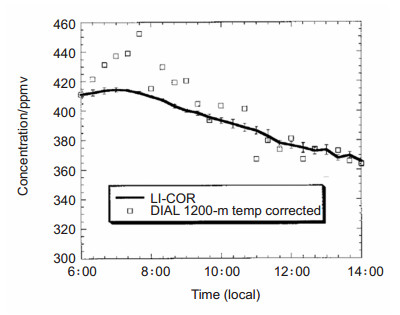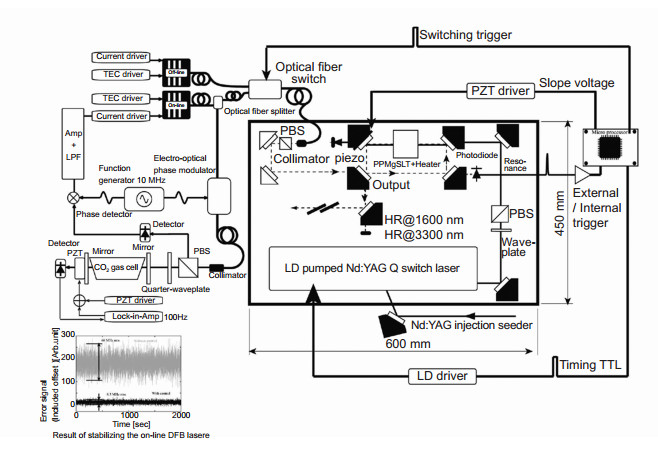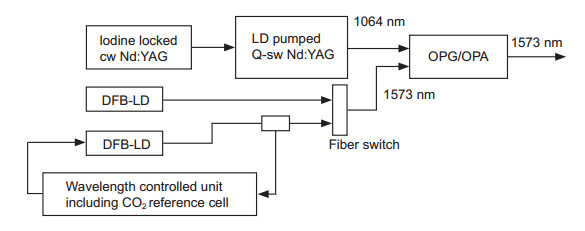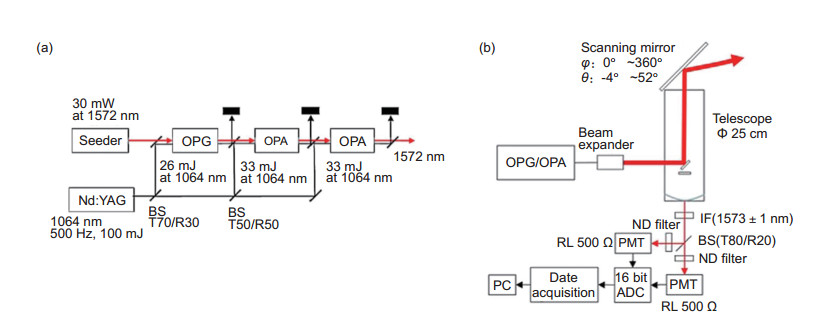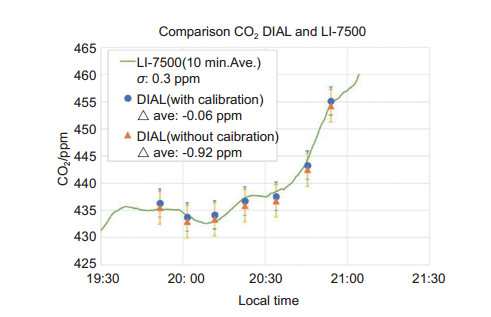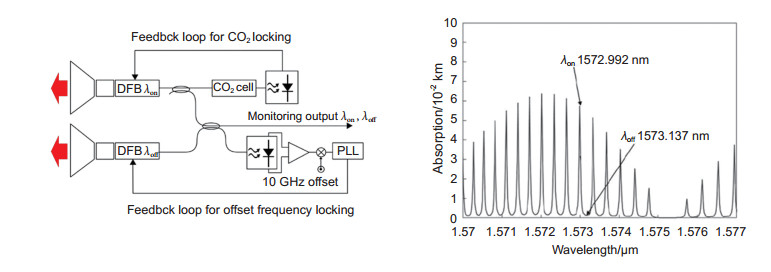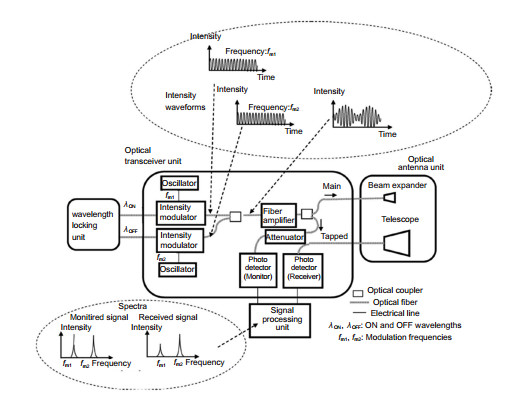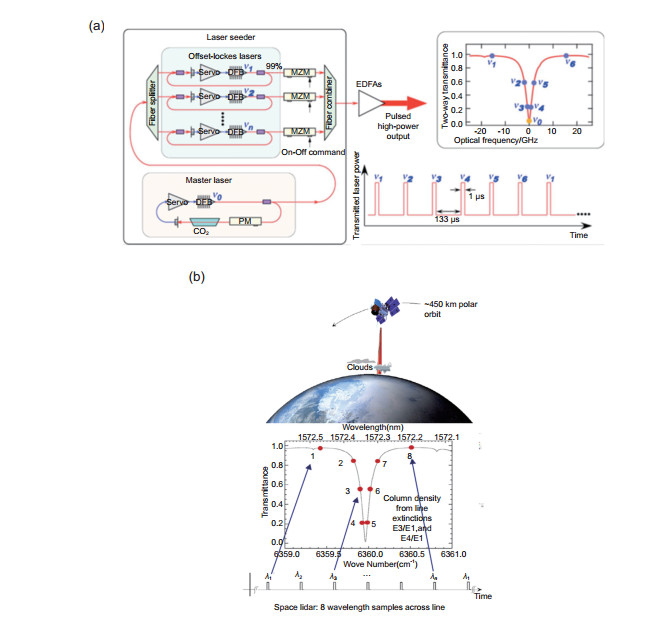-
摘要
差分吸收激光雷达是探测大气CO2时间和空间分布不可或缺的工具。2.0 μm波段Ho:Tm:YLF或Ho:Tm:LuLiF激光器复合外差接收机,1.6 μm种子注入的KTP光参量振荡器或参量发生器复合光电倍增管的光子计数技术,可以探测7 km以下对流层大气CO2混合比的分布。调制连续波种子激光强度、共用1.6 μm光纤放大器,以及相关检测技术的使用,积分路径差分吸收激光雷达在大气CO2柱浓度探测方面具有独特的优点和特色。探测大气二氧化碳柱浓度的空间计划有美国NASA的ASENDS计划,采用脉冲式、积分路径差分吸收工作方式。用CO2气体吸收池作为参照物, 稳定种子光频率和精确控制谐振腔长,锁定发射机的on光源波长,是差分吸收激光雷达探测大气二氧化碳的关键技术。
Abstract
Differential absorption lidar is an indispensable tool to measure atmospheric CO2 for temporal and spatial distribution. The 2.0 μm wavelength Ho:Tm:YLF/Ho:Tm:LuLiF lidar were used for remote sensing atmospheric CO2 with heterodyne receiver. The KTP parametric oscillator was injected into the seeds, and a differential absorption lidar (DIAL) system of 1.6 μm by using the photon counting technique to profile the atmospheric CO2 in the troposphere under 7 km. Modulation continuous wave seed laser intensity and the integral path differential absorption lidar, common 1.6 μm optical fiber amplifier, and the use of correlation detection technique, have unique advantages and characteristics in the detection of atmospheric CO2 column concentrations. The space program for detecting atmospheric CO2 column concentrations is NASA's ASENDS (active sensing of CO2 emission over nights, days, and seasons) mission which adopts the method of pulse and integral path differential absorption. The absorption of CO2 gas cell as a reference to stabilize seed light frequency and the precise control of cavity length lock the on-line wavelength of transmitter, is the key technique for DIAL to measure atmospheric CO2.
-
Key words:
- lidar /
- differential absorption lidar(DIAL) /
- carbon dioxide /
- volume mixed ratio
-
Overview

Overview: Accurate measurements of tropospheric CO2 mixing ratios are needed to study CO2 emissions and CO2 exchange with the land and oceans. 1.6 μm transmitter is based on an injection-seeded KTP optical parametric oscillator. Accurate control of the OPO cavity length ensures powerful single-mode narrow-band pulsed signal radiation out. Combined PMT photon counting technique, this DIAL can profile CO2 through the planetary boundary layer (PBL) and into the free troposphere. A double-pulse 2.05 μm high-energy Ho:Tm:YLF laser, tuned to on- and off-line CO2 absorption wavelengths, has been developed. Transmitter operation and performance have been verified on ground and airborne platform. This instrument has the potential to enhance both spatial and temporal resolution for CO2 global measurement during day and night. The IPDA lidar relies on the measurement of the laser echoes reflected by hard targets as the ground or the top of the vegetation to measure atmospheric CO2 column concentration. The system can take advantage of a less power demanding semiconductor laser in intensity modulated continuous wave operation, benefiting from a better efficiency, reliability and radiation hardness. Such a time-gated technique is a promising way to overcome the sources of systematic errors inherent to passive missions. Coherent detection instruments are generally limited by speckle noise, while direct detection instruments suffer from high detector noise using current technology. The ASCENDS mission will be the first laser spectroscopy from space with the objective to profile CO2 column integrals for climate emissions. The approach uses two tunable pulsed laser transmitters allowing simultaneous measurement of the absorption from a CO2 absorption line in the 1572 nm band, O2 absorption in the oxygen A-band, and surface height and atmospheric backscatter in the same path. To scale for space, It is needed to increase the energy per pulse in each of these wavelengths (1.53 μm and 1.57 μm) to appropriate levels. These are for a 500 km orbit, a 1.5 m diameter telescope and a 10 second integration time, which allows a 70 km along track integration in low earth orbit. HgCdTe APD detector photon counting technique and Si APD photon counting technique will be developed. The on-channel MOPA will be locked to the selected CO2 absorption line using a multi pass CO2 reference cell and a feedback loop based on the Pound-Drver-Hall detector used to generate a low noise error signal, or the lock-in regulator accomplishing top-of-fringe frequency stabilization laser frequency locking equipment. A second feedback loop will be used to stabilize the beat note of the on- and off- channel signal at a fixed 10 GHz offset.
-

-
图 4 法国科学家Gibert等人研制的外差式差分吸收激光雷达系统框图(2015)。EOM:电光调制器;AOM:声光调制器;PID:比例积分微分;PDH:相位调制光外差稳频;AOFS:声光频移器;TDFA:掺铥光纤放大器;PBS:偏振分束器;HWP:半波片;QWP:四分之一波片;PZT:压电换能器
Figure 4. The coherent differential absorption lidar (CDIAL) consists in a 2.05-μm pulsed oscillator, a dual-wavelength seeding module locked to a frequency reference system and a coherent detection (2015). EOM: electro-optic modulator; AOM: acousto-optic modulator; PID: proportional integral and differential; PDH: pound drever hall; AOFS: acousto-optic frequency shifter; TDFA: Thulium doped fiber amplifier; PBS: polarization beam splitter; HWP: half-wave plate; QWP: quarter-wave plate; PZT: piezo-electric transducer
图 5 相干差分吸收激光雷达CO2混合比廓线(20h时间长度)实验,时间分辨率15 min,空间分辨率100 m。(a) CO2干空气混合比横截面图,时间分辨率15 min,距离分辨率150 m;(b)相干差分吸收激光雷达和在线XCO2测量时间序列;(c)相干差分激光雷达(黑线和在线(蓝线) XCO2测量实验,相干差分吸收激光雷达标准方差(黑色点虚线)和在线(蓝线) XCO2测量(红色点虚线)
Figure 5. CDIAL CO2-mixing ratio profiling during the 20-h-long time experiment above Ecole Poly technique campus. Time and space resolution are 15 min and 100 m, respectively. (1–3) is for the cross section reported in Figs. 3(a) and 3(b); (b) Time series of CDIAL and in situ XCO2 measurements; (c) Experimental CDIAL (black line) and in situ (blue line) XCO2 standard deviation (over a slicing 2-h time gate) and CDIAL instrumental standard deviation on XCO2 from α (black dashed line) and WF (red dashed and dotted line)
图 12 BRIDGE激光雷达的组成框图(a)以及探测火山灰中CO2含量的二维截面分布图(b)
Figure 12. Example of two CO2 concentration maps (B, C) obtained during a Pizzo horizontal scan on June 26. Geometry of the scans and location of the plumeare schematically shown in (A). The maps show the distribution of CO2 concentrations in the lidar's field of view (FOV), as a function of heading angle and range.Each map was obtained by interpolation of all CO2 concentration profiles (e.g., same as 3A), obtained during a given Pizzo scan. In the maps, the red coloredhorizontal bands identify the margin of the Pizzo peak (heading angle: 244°~245°), while the volcanic plume is the band of peak CO2 concentration (up to 60 ppm) areas at heading angles of 245°~250°
表 1 法国科学家的报道的三次研究结果性能对比
Table 1. Performance comparison of three literature cover
2015 2008 2006 Laser 2 μm 2 μm 2 μm Ho:YLF Tm, Ho:YLF Tm, Ho:YLF Energy/mJ 10 10 80 PRF/Hz 1 k 5 2.5 Duration/ns 40 230 140 Detection Coherent Coherent Coherent Time/min 15 30 30 Space/m 150 1000 500 Distance/km < 1 < 1 < 2 Precision/% 0.5~2 2 0.7 -
参考文献
[1] Ramanathan A K, Mao J P, Abshire J B, et al. Remote sensing measurements of the CO2 mixing ratio in the planetary boundary layer using cloud slicing with airborne lidar[J]. Geophysical Research Letters, 2015, 42(6): 2055–2062. doi: 10.1002/2014GL062749
[2] Koch G J, Barnes B W, Petros M, et al. Coherent differential absorption lidar measurements of CO2[J]. Applied Optics, 2004, 43(26): 5092–5099. doi: 10.1364/AO.43.005092
[3] Koch G J, Beyon J Y, Gibert F, et al. Side-line tunable laser transmitter for differential absorption lidar measurements of CO2: design and application to atmospheric measurements[J]. Applied Optics, 2008, 47(7): 944–956. doi: 10.1364/AO.47.000944
[4] Gibert F, Flamant P H, Bruneau D, et al. Two-micrometer heterodyne differential absorption lidar measurements of the atmospheric CO2 mixing ratio in the boundary layer[J]. Applied Optics, 2006, 45(18): 4448–4458. doi: 10.1364/AO.45.004448
[5] Porcheron F, Gibert A, Jacquin M, et al. High Throughput Screening of amine thermodynamic properties applied to post-combustion CO2 capture process evaluation[J]. Energy Procedia, 2011, 4(1): 15–22. https://www.researchgate.net/profile/Ludovic_Raynal/publication/229218205_High_Throughput_Screening_of_amine_thermodynamic_properties_applied_to_post-combustion_CO2_capture_process_evaluation/links/0deec526e180e5fa5a000000.pdf?origin=publication_list
[6] Gibert F, Edouart D, Cenac C, et al. 2-μm Ho emitter-based coherent DIAL for CO2 profiling in the atmosphere[J]. Optics Letters, 2015, 40(13): 3093–3096. doi: 10.1364/OL.40.003093
[7] Sakaizawa D, Nagasawa C, Nagai T, et al. Development of a 1.6 microm differential absorption lidar with a quasi-phase-matching optical parametric oscillator and photon-counting detector for the vertical CO2 profile[J]. Applied Optics, 2009, 48(4): 748–757. doi: 10.1364/AO.48.000748
[8] Shibata Y, Nagasawa C, Abo M. Development of 1.6 μm DIAL using an OPG/OPA transmitter for measuring atmospheric CO2 concentration profiles[J]. Applied Optics, 2017, 56(4):1194– 1201. doi: 10.1364/AO.56.001194
[9] Amediek A, Fix A, Wirth M, et al. Development of an OPO system at 1.57 μm for integrated path DIAL measurement of atmospheric carbon dioxide[J]. Applied Physics B, 2008, 92(2): 295–302. https://link.springer.com/article/10.1007/s00340-008-3075-6
[10] Amediek A, Ehret G, Fix A, et al. CHARM-F a new airborne integrated-path differential-absorption lidar for carbon dioxide and methane observations: measurement performance and quantification of strong point source emissions[J]. Applied Optics, 2017, 56(18): 5182–5197. doi: 10.1364/AO.56.005182
[11] Singh U N, Yu J R, Petros M, et al. Development of a pulsed 2-micron integrated path differential absorption lidar for CO2 measurement[J]. Proceedings of SPIE, 2013, 8872: 887209. doi: 10.1117/12.2028245
[12] Singh U N, Yu J R, Petros M, et al. Airborne 2-micron double-pulsed integrated path differential absorption lidar for column CO2 measurement[J]. Proceedings of SPIE, 2014, 9246: 924602. doi: 10.1117/12.2069670
[13] Sakaizawa D, Kawakami S, Nakajima M, et al. Ground-based demonstration of a CO2 remote sensor using a 1.57 μm differential laser absorption spectrometer with direct detection[J]. Journal of Applied Remote Sensing, 2010, 4(1): 043548. doi: 10.1117/1.3507092
[14] Lin Bing, Ismail S, Harrison F W, et al. Modeling of intensity-modulated continuous-wave laser absorption spectrometer systems for atmospheric CO2 column measurements[J]. Applied Optics, 2013, 52(29): 7062–7077. doi: 10.1364/AO.52.007062
[15] Campbell J F, Lin B, Nehrir A R. Advanced sine wave modulation of continuous wave laser system for atmospheric CO2 differential absorption measurements[J]. Applied Optics, 2014, 53(5): 816–829. doi: 10.1364/AO.53.000816
[16] Aiuppa A, Fiorani L, Santoro S, et al. New advances in dial-lidar-based remote sensing of the volcanic CO2 flux[J]. Frontiers in Earth Science, 2017, 5: 15. https://www.frontiersin.org/articles/10.3389/feart.2017.00015/full
[17] Michalak A, Miller C, Briwell E, et al. ASCENDS—active sensing of CO2 emissions over nights, days, and seasons (ASCENDS) mission[R]. Technical report. Michigan: University of Michigan in Ann Arbor, 2008.
http://www.researchgate.net/publication/253883046_Active_Sensing_of_CO2_Emissions_over_Nights_Days_and_Seasons_(ASCENDS) [18] Abshire J B, Riris H, Allan G R, et al. pulsed airborne Lidar measurements of atmospheric CO2 column absorption[J]. Tellus B, 2010, 62(5): 770–783. doi: 10.1111/j.1600-0889.2010.00502.x
[19] Abshire J B, Riris H, Weaver C J, et al. Airborne meas-urements of CO2 column absorption and range using a pulsed direct-detection integrated path differential absorption lidar[J]. Applied Optics, 2013, 52(19): 4446–4461. doi: 10.1364/AO.52.004446
[20] Ingmann P, Bensi P, Duran Y, et al. A-scope–advanced space carbon and climate observation of planet earth[R]. ESA Report for Assessment, SP-1313/1. ESA, 2008.
[21] Numata K, Chen J R, Wu S T, et al. Frequency stabilization of distributed-feedback laser diodes at 1572 nm for lidar measurements of atmospheric carbon dioxide[J]. Applied Optics, 2011, 50(7): 1047–1054. doi: 10.1364/AO.50.001047
[22] Koch G J, Dharamsi A N, Fitzgreald C M, et al. Frequency stabilization of a Ho:Tm:YLF laser to absorption lines of car-bon dioxide[J]. Applied Optics, 2000, 39(21): 3664–3669. doi: 10.1364/AO.39.003664
[23] Ambrico P F, Amodeo A, Di Girolamo P, et al. Sensitivity analysis of differential absorption lidar measurements in the mid-infrared region[J]. Applied Optics, 2000, 39(36): 6847–6865. doi: 10.1364/AO.39.006847
[24] Esquivias I, Consoli A, Krakowski M, et al. High-brightness all semiconductor laser at 1.57 μm for space-borne lidar measurements of atmospheric carbon dioxide: device design and analysis of requirements[J]. Proceedings of SPIE, 2014, 9135: 913516. doi: 10.1117/12.2052191
[25] Refaat T F, Singh U N, Yu J R, et al. Double-pulse 2-μm integrated path differential absorption lidar airborne validation for atmospheric carbon dioxide measurement[J]. Applied Optics, 2016, 55(15): 4232–4246. doi: 10.1364/AO.55.004232
[26] Wagner G A, Plusquellic D F. Ground-based, integrated path differential absorption LIDAR measurement of CO2, CH4, and H2O near 1.6 μm[J]. Applied Optics, 2016, 55(23): 6292– 6310. doi: 10.1364/AO.55.006292
[27] YU Ji-rong, Petros M, Singh U N, et al. An airborne 2-μm double-pulsed direct-detection lidar instrument for atmospheric CO2 column measurements[J]. Journal of Atmospheric and Oceanic Technology, 2017, 34(2): 385–400. doi: 10.1175/JTECH-D-16-0112.1
[28] Reffaat T F, Singh U N, Yu J R, et al. Evaluation of an airborne triple-pulsed 2 μm IPDA lidar for simultaneous and independent atmospheric water vapor and carbon dioxide measurements[J]. Applied Optics, 2015, 54(6): 1387–1398. doi: 10.1364/AO.54.001387
-
访问统计


 E-mail Alert
E-mail Alert RSS
RSS

 下载:
下载:
